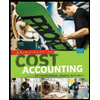
(a)
Concept introduction:
Direct Cost:
The cost which is directly related to the product and affects those items directly, which contributes to the revenue generation in the business is referred as direct cost.
Indirect Cost:
The cost which is not directly related to the product and does not affect those items directly, which contributes to the revenue generation in the business is referred as indirect cost. These can be fixed cost or such costs are incurred as a whole and cannot be make relation to
The reason behind increment in the cost per plaque.
(b)
Concept introduction:
Direct Cost:
The cost which is directly related to the product and affects those items directly which contributes to the revenue generation in the business is referred as direct cost.
Indirect Cost:
The cost which is not directly related to the product and does not affect those items directly which contributes to the revenue generation in the business is referred as indirect cost. These can be fixed costs or such costs are incurred as a whole and cannot be make relation to manufacturing cost.
The area of concern for HT on the basis of unit costs.
Trending nowThis is a popular solution!

Chapter 10 Solutions
CengageNOWv2, 1 term Printed Access Card for Warren's Survey of Accounting, 8th
- Upon completing an aging analysis of accounts receivable, the accountant for Riverside Manufacturing prepared an aging of accounts receivable and estimated that $9,300 of the $142,500 accounts receivable balance would be uncollectible. The allowance for doubtful accounts had a $850 credit balance at year-end prior to adjustment. How much is the bad debt expense? a. $8,450 b. $6,580 c. $7,820 d. $7,200 helparrow_forwardIf management has a targeted net incomearrow_forwardProvide correct solution and accountingarrow_forward
- Please provide the solution to this general accounting question using proper accounting principles.arrow_forwardCan you demonstrate the accurate steps for solving this financial accounting problem with valid procedures?arrow_forwardI am looking for help with this general accounting question using proper accounting standards.arrow_forward
- Camila Products' break-even point in units is 3,400. The sales price per unit is $15 and the variable cost per unit is $8. If the company sells 6,800 units, what will its net income be? a. $30,600 b. $23,800 c. $47,600 d. $54,400 e. $37,400arrow_forwardWhat is the estimated variable delivery cost?arrow_forwardWhat is the initial margin requirement ?arrow_forward
- Solve this financial accounting problemarrow_forwardCalculate the cash collected from customersarrow_forwardBased on potential sales of 800 units per year, a new product at Waverly Manufacturing has estimated traceable costs of $1,600,000. What is the target price to obtain a 25% profit margin on sales? A. $2,500.68 B. $2,400.21 C. $2,666.67 D. $1,950.55 solve this problemarrow_forward
 Managerial AccountingAccountingISBN:9781337912020Author:Carl Warren, Ph.d. Cma William B. TaylerPublisher:South-Western College Pub
Managerial AccountingAccountingISBN:9781337912020Author:Carl Warren, Ph.d. Cma William B. TaylerPublisher:South-Western College Pub Cornerstones of Cost Management (Cornerstones Ser...AccountingISBN:9781305970663Author:Don R. Hansen, Maryanne M. MowenPublisher:Cengage LearningPrinciples of Accounting Volume 2AccountingISBN:9781947172609Author:OpenStaxPublisher:OpenStax College
Cornerstones of Cost Management (Cornerstones Ser...AccountingISBN:9781305970663Author:Don R. Hansen, Maryanne M. MowenPublisher:Cengage LearningPrinciples of Accounting Volume 2AccountingISBN:9781947172609Author:OpenStaxPublisher:OpenStax College Principles of Cost AccountingAccountingISBN:9781305087408Author:Edward J. Vanderbeck, Maria R. MitchellPublisher:Cengage Learning
Principles of Cost AccountingAccountingISBN:9781305087408Author:Edward J. Vanderbeck, Maria R. MitchellPublisher:Cengage Learning Financial And Managerial AccountingAccountingISBN:9781337902663Author:WARREN, Carl S.Publisher:Cengage Learning,
Financial And Managerial AccountingAccountingISBN:9781337902663Author:WARREN, Carl S.Publisher:Cengage Learning, Managerial Accounting: The Cornerstone of Busines...AccountingISBN:9781337115773Author:Maryanne M. Mowen, Don R. Hansen, Dan L. HeitgerPublisher:Cengage Learning
Managerial Accounting: The Cornerstone of Busines...AccountingISBN:9781337115773Author:Maryanne M. Mowen, Don R. Hansen, Dan L. HeitgerPublisher:Cengage Learning





